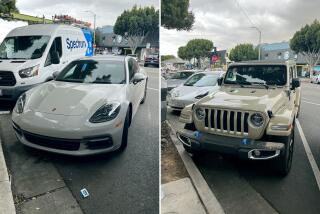Hyundai Remodels Its Image : Ad Campaign Makes U-Turn in Drive to Speed Up Slowing Sales
- Share via
FOUNTAIN VALLEY — Hyundai Motor America, which swept the U.S. market with its Excel in 1986 only to see sales plunge last year, is preparing to unveil a new national advertising campaign aimed at persuading car buyers that it is no longer a one-trick pony.
While the Hyundai Excel was perhaps the most successful import car launch ever, sales began a precipitous plunge in 1989--and are still dropping. And Hyundai’s mid-size Sonata, introduced early last year, has never really taken off.
Hyundai was branded, by its own advertising, as a inexpensive little car for the entry-level buyer. But now the South Korean auto maker, whose U.S. marketing arm is based in Fountain Valley, wants to change that image.
The nearly $100-million all-media advertising campaign, by Backer Spielvogel Bates/Irvine, will dump the now-tired “World Class Cars” tag line and begin trumpeting Hyundai as a car maker that provides value for almost every taste.
The campaign, which will be unveiled Monday, should squelch rumors that the auto maker is unhappy with Backer Spielvogel--which created the successful “Cars that Make Sense” campaign that launched Hyundai’s entry into the U.S. market.
The new campaign, Hyundai officials hope, is one that will help restore the company’s once-spectacular momentum.
Both Hyundai and Backer Spielvogel are remaining tight-lipped about the new campaign, which will be inaugurated Sept. 17 in conjunction with the official introduction of the Scoupe, a 2+2 sports coupe built on the Excel chassis.
The sporty Scoupe is considered an “image car,” with a base price of $8,325. The company also intends to add a fourth model--a compact sedan based on a new “J” platform--to its line early next year.
Rod Hayden, executive vice president and chief operating officer of Hyundai Motor America, said the new ad campaign is intended to build a different image for Hyundai--to “reposition us in the market.” The basic premise of the campaign will be to show that a Hyundai is both a value and an exciting, well-made and well-equipped car, said Harry W. Gresche, senior vice president and management representative at Backer Spielvogel in Irvine.
Ads in the new campaign will present a list of impressive features--items that the average car shopper might not expect to find on cars priced in the $6,500-$13,000 range.
The kicker, Gresche said, will be the underscored line, “Yes, Hyundai!”
As part of the image remake, Hayden said in an interview earlier this summer, a Hyundai design center will be in full swing in Fountain Valley by early next year to help impart a distinctly American flavor to cars intended for the U.S. market. Other plans call for:
* Continued upgrading of Hyundai models, with appropriate price increases, to help expand the product mix and create more reasons for Hyundai buyers to return to the company’s dealerships;
* Possible development of higher-performance engines for the Scoupe and the top-of-the-line Sonata;
* The current force of 380 dealerships to swell to 750 by late 1992, greatly expanding Hyundai’s penetration of secondary markets.
But the new ad campaign is the cornerstone of Hyundai’s building plans.
The company needs a new image, automotive analysts say, because the old one has been killing it.
“In general, Hyundai now has two challenges,” said automotive marketing consultant David Hillburn, whose Los Angeles-based Hillburn & Associates helped with the initial Hyundai launch in 1986. “The first is repositioning and making the transition from an economy-car company to a full-line manufacturer.”
The company’s second challenge, Hillburn said, is dealing with the industrywide slump. “They are trying to do this at a time just about all car companies are losing sales,” he said. “That isn’t just a Hyundai problem, it’s an industry problem.”
Despite the much-discussed drop in Hyundai’s sales--which are off nearly 40% from the peak year of 1988--analysts say the company still is doing well, outselling Subaru, Isuzu, Suzuki and Daihatsu and trailing not too far behind Mitsubishi.
Hyundai’s need to reposition “is basic,” said William E. Hamilton, the company’s director of product and market planning. “We have a name that is synonymous with entry level in the American mind . . . but now we offer cars for three segments and have a fourth coming out next year,” he said.
The expansion of the Hyundai line has occurred just since the beginning of 1989, Hamilton said. “Now we’ve got to get the consumer to shift gears about what Hyundai is,” he said.
Being the cute, cheap little car from Korea worked for several years, enabling Hyundai to create a whole new car market in the United States--providing serviceable new cars at what had been used-car prices.
But Hyundai--which introduced the Excel at under $6,000 at a time the average new car in the United States sold for nearly $12,000--was so successful it attracted a host of competitors. By late 1988 the market for low-cost compact cars was overcrowded, said Arvid Jouppi, Michigan-based auto analyst for Keane Securities of New York.
Early Excel owners looking to trade up were turned away because they couldn’t buy a bigger Hyundai if they wanted to. And prospective first-time Hyundai buyers grew bored with the unchanging styling of the Excel and were shopping other dealers’ lots by the time the Sonata showed up nearly a third of the way through the 1989 model year.
HYUNDAI SALES / Los Angeles Times
Annual totals, in thousands of units
TRYING TO SHIFT HYUNDAI OUT OF REVERSE
EXCEL: Total units sold in U.S.
1986: 168,882
1987: 263,610
1988: 264,282
1989: 148,563
1990: 100,000
1991: 100,000
SONATA
1986: Not For Sale
1987: Not For Sale
1988: Not For Sale
1989: 34,698
1990: 45,000
1991: 40,000
Source: Hyundai Motor of America






